Part IV: Pleistocene Epoch
36. Homo sapiens
Early Anatomically Modern Humans
Homo sapiens (>200 kya)
(“human” / “capable of discerning”)
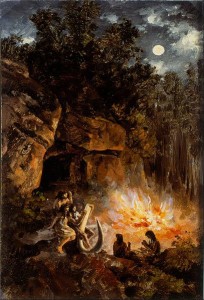
SITES
Africa:
Tanzania: Ngaloba
Kenya: Guomde
Ethiopia: Omo Kibish and Herto
Democratic Republic of Congo: Katanda
South Africa: Border Cave and Klasies River Mouth
Asia (the following are earliest regional sites):
Israel: Skhul and Jebel Qafzeh
Mongolia: Ordos
Europe (the following are famous sites):
France: Cro Magnon (the most famous site in France)
Germany, Italy, Spain
Australia (the following are earliest regional sites):
Mungo Lake and Kow Swamp
New World (the earliest regional site):
Chile: Mesa Verde
PEOPLE
Too numerous to mention, as one or more individuals work at each site and sites are numerous, especially in Eurasia
INTRODUCTION
My discussion of early AMH will cover their existence and culture prior to the Mesolithic period (~12 kya) only and will focus primarily on European sites due to the paucity of information from earlier and non-European sites.
PHYLOGENY
The origin of our species is thought to have occurred in Africa sometime prior to 200 kya, based on fossil and genetic evidence. We may be descended from an African population of Homo heidelbergensis (sometimes referred to as Homo rhodesiensis) or an earlier common ancestor of heidelbergensis, based on recent genetic evidence. Fossils characteristic of a transitional form, termed Homo helmei, are found at the South African site of Florisbad and dated to 260 kya. Material from the Herto site in Ethiopia (Middle Awash area of the Afar Depression) is dated to 160 kya and sometimes referred to as Homo idaltu or Homo sapiens idaltu. Homo idaltu may be descended from the earlier South African form(s) and the most recent ancestor of AMH.
Groups of AMH made one or more exoduses out of Africa during the Late Pleistocene. The ancestors of some Southeast Asians and the earliest Australians (as well as inhabitants of surrounding islands and those that were used as “stepping stones”) may have left Africa ~125 kya. There are sites dating to ~120 kya in the Middle East. A later group left prior to 50 kya and populated Eurasia and the New World, and made their way to the South Pacific as well, where they must have come into contact and interbred with the previously existing humans there.
The AMH ancestors of Eurasians interbred with neandertals, so that living descendants have inherited an average of 2.5% of neandertal genes. Some Southeast Australasians inherited both neandertal and Denisovan genes, due to interbreeding, and they carry ~7% of genes from those two species.
DISCOVERY AND GEOGRAPHIC DISTRIBUTION
Most of the oldest AMH material has been discovered in more recent times, relative to early discoveries of Asian Homo erectus and neandertal remains. The earliest AMH material is dated to 200–150 kya in East Africa (e.g. Omo Kibish and Herto in Ethiopia, Guomde in Kenya, and Ngaloba in Tanzania), 180 kya in central Africa (Katanda in the Democratic Republic of Congo), and 160 kya in South Africa (e.g. Klasies River Mouth). Later sites dated to 115 kya are found in Israel (Skhul and Jebel Qafzeh caves) and South Africa (Border Cave).
Due to increasing aridification during the Late Pleistocene of sub-Saharan Africa, researchers speculate that there were few areas that would have been habitable for early AMH. South Africa and other coastal areas likely served as refugia during those times.
By 125 kya, it would have been possible for AMH to have left Africa during a short interglacial period (see Figure 36.2 for routes and dates of arrival throughout the world). Middle Eastern sites dated to <120 kya preserve evidence of AMH. The Arabian land bridge likely served as a corridor to Southeast Asia, just as it had for the ancestor of Homo erectus. By ~50 kya, that early wave of humans made it all the way to Australia. Archaeological sites dated to over 50 kya are found in Japan and Australia (with cave art possibly as old as 75 kya), and fossil material from Australia is dated to 40 kya. Some researchers see similarities between early Australians and early Africans, supporting the idea of at least two African exoduses and multiple human migrations into the South Pacific. The first wave left Africa first and arrived by 50 kya. Ancestors of AMH that left Africa during the “second” exodus followed at a later point in time. It is not known when they arrived in the various areas of Southeast Asia or whether they made it to the same destinations as the original colonizing group, prior to modern times.

The earliest date for AMH in Eurasia is from the Ordos site in Mongolia at 50 kya. AMH reached Western Europe by 35 kya. Sites are found in Germany, France, Italy, and Spain, with the best-known site being the Cro-Magnon site in Les Ezies, France. The Cro-Magnon site gave the name to the earliest people of Western Europe and is the location where the “Old Man of Cro-Magnon” (see Figure 36.3) was found in 1868 by Louis Lartet.
By 15 kya, humans had spread throughout the world. They reached the New World, either by rafting along the shoreline from Asia during extremely low sea levels that characterized the last glacial maximum (~17 kya) or by crossing the Bering Land Bridge at a later point in time. Dates in South America (~14 kya) are older than those in North America and represent the former mode of travel. Sea levels dropped by as much as 120 m during that time. Crossing Beringea involved traveling between two ice shields and was likely a difficult undertaking.
PHYSICAL CHARACTERISTICS
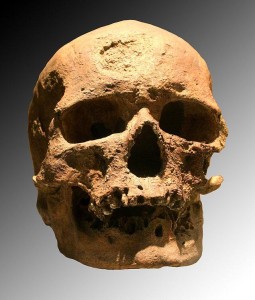
AMH are distinguished from Homo heidelbergensis and rhodesiensis by a suite of cranial characteristics and continued loss of robusticity, both cranially and postcranially. AMH skulls were more vertically oriented with thinner bones. While the cranial capacity (mean = 1450 cc) was lower relative to neandertals, the brain was architecturally different, and corresponding behavior was more complex and indicative of greater lateralization. The parietal and frontal lobes were expanded, resulting in high maximum width and breadth and a more pronounced forehead. Those areas of the cerebrum are involved with higher thought-processing skills related to association, speech, and all of the other cognitive capabilities that make us unique relative to other species, past and present. The face was shorter, the orbits were more rectangular, and the brow ridges were less pronounced. The brows are termed bipartite in that they are characterized by a slight bulge on either side of the nose, with a break in between. While the nose may have been pronounced, the nasal opening was narrower, and the midfacial prognathism seen in earlier forms was absent. Jaw and dental robusticity became further reduced. AMH are characterized by a chin, or mental eminence (an autapomorphic, or unique, trait in AMH). While the mandible was less robust, the morphology (described as an inverted T-shape) was strong and stress resistant.


Because they had more gracile and hence lighter faces, they needed stronger anterior neck muscles to flex the head from an extended position, i.e. from a back-tilted to a forward-tilted position. The sternocleidomastoid muscle (see Figure 36.4) accomplishes that action, along with some rotation. The muscle originates on the sternum and clavicle and inserts on the mastoid process (bony projections posterior to ears; see Figure 36.5). The mastoid process became more pronounced to handle the additional power that was necessary (Campbell 1998).
Postcranially, AMH exhibited narrow hips, long legs, and thinner long bones than H. heidelbergensis or neanderthalensis. While they were seemingly not as cold-adapted as neandertals, they moved into northern latitudes and survived through the last glacial maximum. It is strange that the seemingly more heat-adapted humans survived and the robust neandertals did not. However, their long legs and more gracile morphology were less energetically costly and afforded them greater endurance and a longer stride and hence greater speed. In addition, cultural adaptations to the climate must have occurred or they could not have survived. They are thought to have made better clothes, shelter, and weaponry and were skilled hunters.
ENVIRONMENT AND WAY OF LIFE
Early AMH arose and lived during the latter part of the Pleistocene Epoch, which was characterized by intermittent glacial and interglacial periods. They ventured into northern latitudes by ~50 kya and stayed and survived in extreme conditions during the period prior to, during, and after the last glacial maximum. Populations that stayed in Africa and other warm regions would certainly have continued with life as usual in the absence of climatic upheaval.
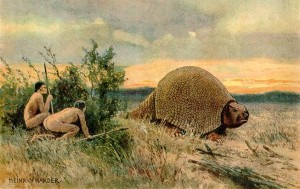
Until the advent of agriculture and the beginning of the modern geological epoch (i.e., the Holocene) approximately 10 kya, humans were mobile to semi-sedentary foragers. They exploited whatever flora and fauna were native and available in the various regions they inhabited and colonized, from mastodons in the far north to wallabies in the far south of the Old World. We really do not need to discuss much about how AMH made a living because we have living and historic examples in the ethnographic record to show us how people lived and adapted, even to environmental extremes, from the cold of the Arctic to the deserts of the world. We have a record of Stone Age populations whose way of life disappeared within my lifetime, such as Australian Aborigines and Amazonian Indians. Like modern foragers, population density would have been low, and life ranged from easy to hard, depending on the availability of resources, seasons, and climatic patterns and disasters. One estimate of mortality rates has 50% of people dying before 20 years of age, few females living beyond 30, and only 12% living beyond the age of 40.
Any discussion of early AMH culture is seemingly Eurocentric, because the majority of the known archaeological record falls between 30 and 20 kya in Western Europe. We know that ~30 kya, a warming trend occurred that lasted several thousand years. As glacial ice retreated, prime grazing land opened and spread from Spain to Siberia. As large game expanded their geographical range, so did humans and other predators. Human population numbers increased as groups spread throughout the habitable landmass. However, as the last glacial maximum approached, ice reclaimed the land and humans were once again restricted in their range and movements.

The vegetation map in Figure 36.7 shows what the world was like beginning about 20 kya, during the last glacial maximum. By that time, AMH were living in Africa, Eurasia, island chains southeast of Asia, and Australia and the surrounding islands. A short time later, they ventured into the New World.
We certainly know that early humans had spoken language, and it would have facilitated their survival via group memory and tradition as well as problem-solving. They were qualitatively different than the neandertals, and their modes of communication were likely more advanced. Modern languages can be traced, showing their spread and evolution over time and geographic space. Some of the symbols that have survived from Paleolithic times, such as dots, dashes, and hand-prints, may have conveyed information. The same may be said for depictions of animals, humans, and hunting on cave walls.
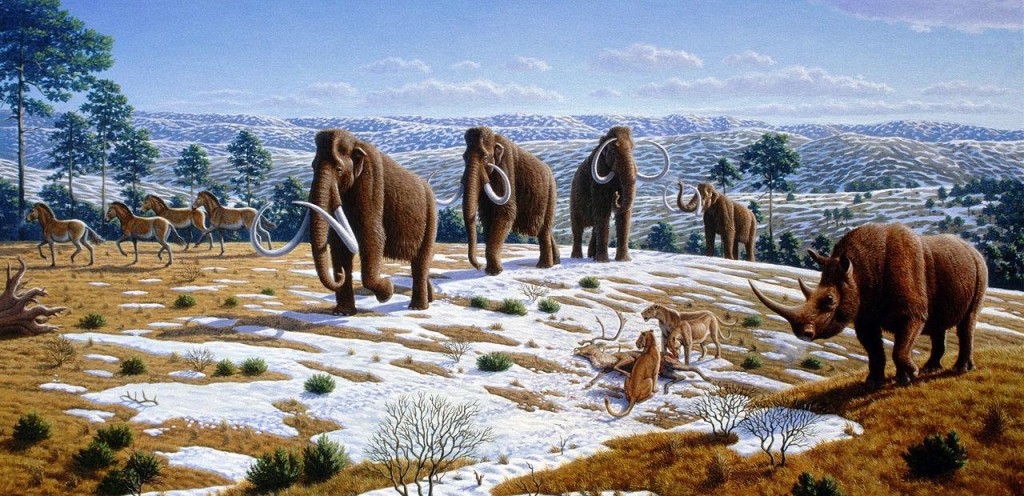
Early AMH culture falls within the period termed the Upper Paleolithic (40–12 kya). Relative to prior Middle Paleolithic sites, AMH cultural achievements are much more impressive. Over time, they made great technological advances, inventing a great variety of new and useful objects and modes of production. People left Africa armed with language, religion, and cultural identity, as they are cultural universals and there is some evidence in the archaeological record that suggests religious practices and initiation rituals (see below). Greater individual expression is apparent in the wonderful representational art that has survived in cave paintings and sculptures, and body adornment in the form of clothing, jewelry, and pigmentation. Complex aspects of culture, such as rules regarding kinship and marriage, also may have preceded the African diaspora(s). They too are cultural universals, and while they likely changed over time in response to need and ecology, they certainly did not evolve independently in all places.
According to Stringer and Andrews (2005), cultural achievements in the various regions of the Old World were as follows:
- Europe ~40 kya:
- All aspects of Upper Paleolithic culture.
- Only early representational art.
- South Africa ~75 kya:
- Blombos Cave.
- Carved and decorated ocher crayons (see Figure 36.9).
- Blombos Cave.
- Australia ~30 kya:
- Rafts.
- Cremation.
- Art.
- Body adornment.
- Bone artifacts.

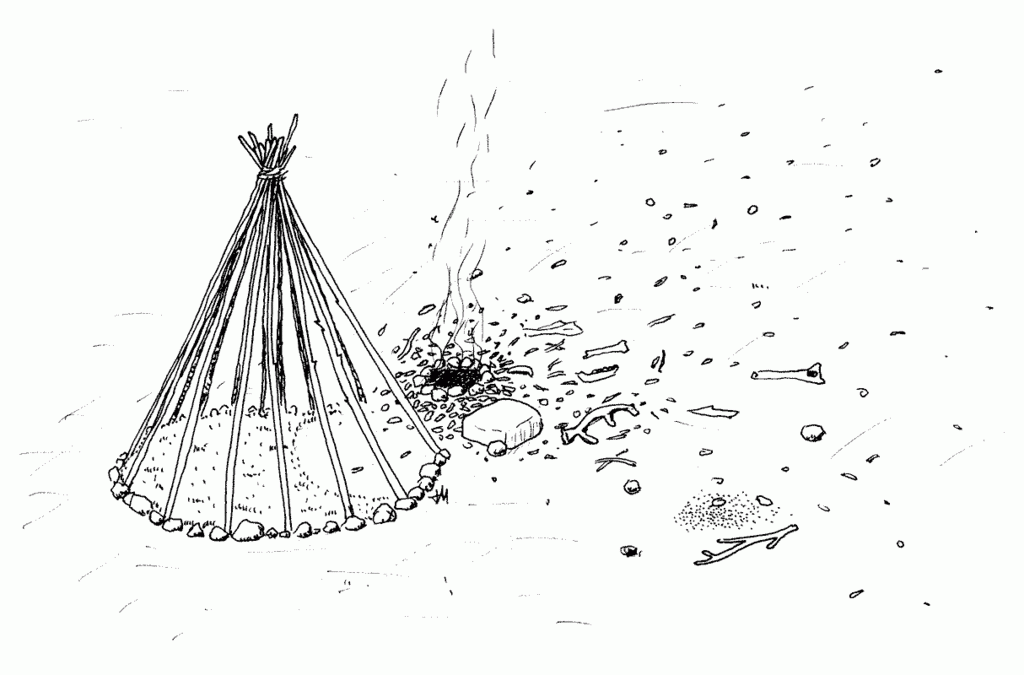
AMH settlements were larger and more permanent than those of neandertals and were often located on the tops of hills. Researchers have speculated that the view of the surrounding areas may have been beneficial for monitoring herd movements. They built better shelters, some of which had sunken and stone foundations. Materials that were utilized consisted of wooden posts and branches, stone, and hides, and where no wood was available, bones, tusks, and antlers. They also made tents (see Figure 36.10). The remains of a house in Russia show that it was approximately 50 by 120′ with multiple hearths along its length. That is four times the size of my house and architecturally impressive, considering their tool kit relative to ours. Cooking was done in stone-lined hearths and ovens. They dug storage pits to preserve and protect food stores from animals. Stone lamps consisted of a flat stone with a depression into which was placed animal fat that would have provided light for a couple of hours.
At the Sungir site near Moscow, clothes from 22 kya survived in permafrost. We thus know that Paleolithic peoples made tailored clothing like our own. Earlier hominins are thought to have worn ponchos and lashed skins onto their bodies. AMH tools of the trade that survive in the archaeological record are bone needles, pins, and awls for punching holes in the skins. In addition to animal hides, they used bark cloth and woven grass for insulation.
Upper Paleolithic tool industries were advanced relative to past traditions, with greater diversification and refinement. Tools consisted of knives, scrapers, chisels, borers, awls, needles, and a greater number of blade and compound tools. Stone, bone, ivory, and antler were used. Some of the more famous Upper Paleolithic industries are the Aurignacian (possibly <40 kya), Gravettian (~28–22 kya), Solutrean (~22–17 kya), and Magdalenian (~18–10 kya).

The Aurignacian industry (see Figure 36.11) may have originated in Asia, but it can be found throughout Europe (Stringer and Andrews 2005). The Cro-Magnon people that produced the tools, art, and other cultural achievements from that time are thus known as the Aurignacian or Cro-Magnon culture. Aurignacian and subsequent tool industries were predominantly blade-based. Like the Levallois technique and the Mousterian industry, AMH could produce a variety of tools from a single core, but they used a new mode of production known as the punch technique. It involved using a hammerstone, a hammer and chisel, or a long wooden spear (using upper body weight and strength) to “punch” blades from the core. For illustrations on this technique see Dennis O’Neil’s Early Modern Human Culture at http://anthro.palomar.edu/homo2/.
The Gravettian industry had a more limited distribution in Eastern Europe and Western Asia (Stringer and Andrews 2005). Stereotypical tools of the industry were flat-end blades and burins (see Figure 36.12) that were used to work wood.
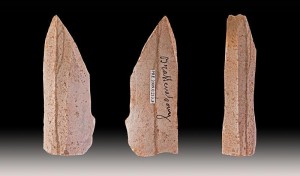
The Solutrean industry (see Figure 36.13) is most famous for its beautiful and refined laurel leaf blades (see Figure 36.14). A method known as pressure flaking was used to finely and bifacially shape the blade. Pressure flaking involves the use of a pointed tool, such as antler or bone, to force tiny flakes from the surface and edges of the tool (see Figure 36.15).
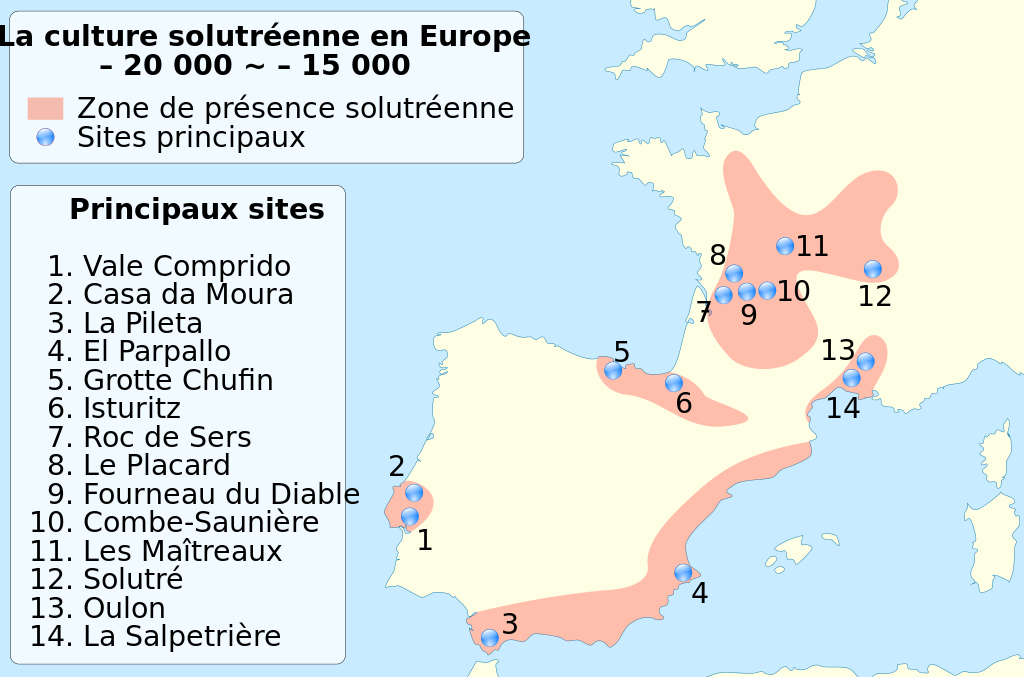
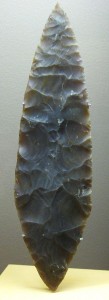
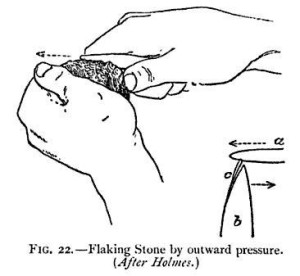
Finally, the Magdalenian industry (see Figures 36.16, 36.17, and 36.18) is characterized by great advances in weaponry, such as the bow and arrow and the atlatl or spear thrower (see Figures 36.19 and 36.20), both of which allowed hunters to put distance between themselves and their prey.
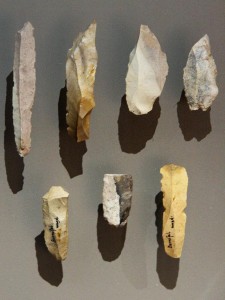
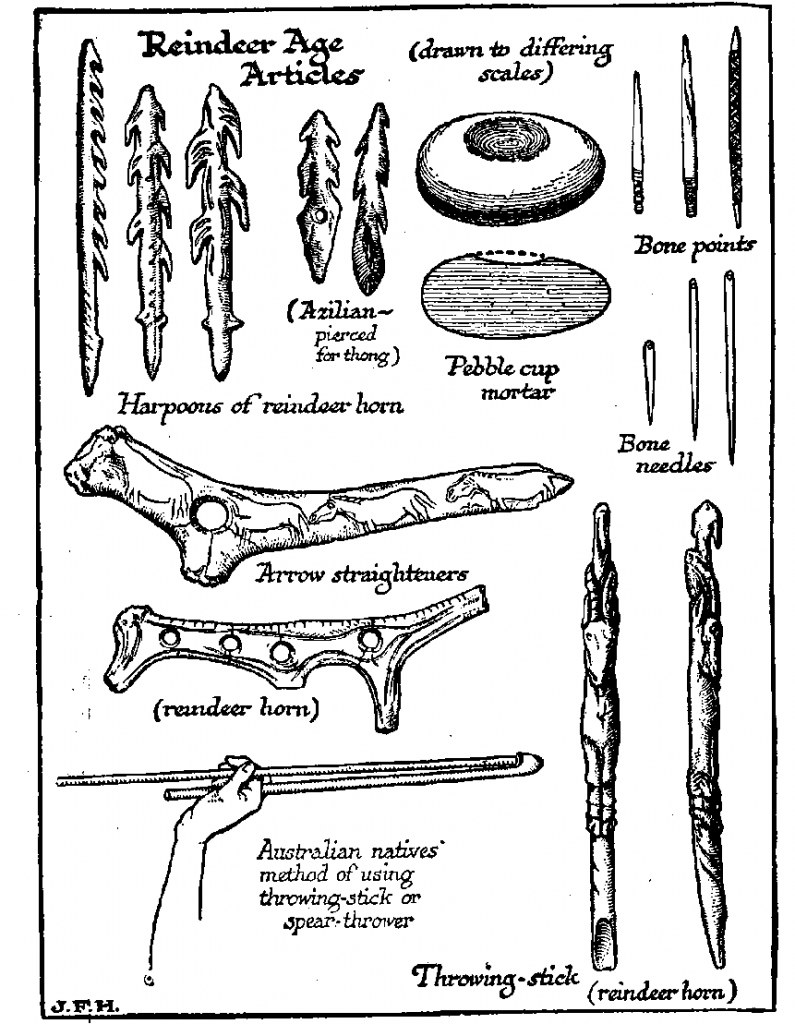

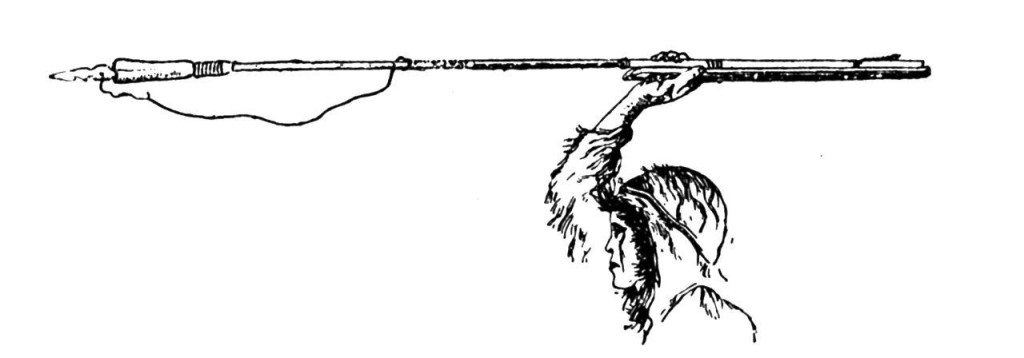

Other weapons from the Upper Paleolithic are stone missiles or bolas (see Figure 36.21), boomerangs, spears, javelins, and clubs. AMH had refined fishing techniques, rafts, and canoes. Harpoons appear very early in the archaeological record, e.g. the Katanda site in the Democratic Republic of Congo is dated to 180–75 kya. They also constructed traps, rope, and baskets.
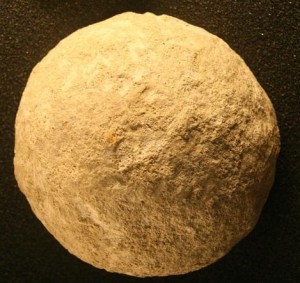
Beginning ~25 kya, a cultural and symbolic explosion is evident in the archaeological record of Western Europe, possibly in response to the increasingly cold temperatures, such as if they spent more time inside caves or were performing rituals aimed at increasing their survival. The Cro-Magnon/Aurignacian people are known for their cave art and sculptures (see Figures 36.23 and 36.24). Figure 36.22 illustrates the incredible number of sites where early AMH art has been found. There are 150 sites in southwest France alone.
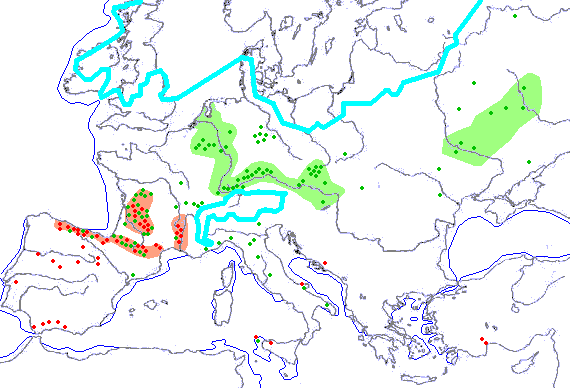
Common cave art themes are fauna; hunting; hands; dots and lines; some humans; and the occasional human costumed as an animal and sometimes dancing, such as “The Sorcerer” (see Figures 36.23 and 36.24). Men appear alone or in groups, but women are never pictured alone. Drawings of male and female genitalia are reported from multiple sites.
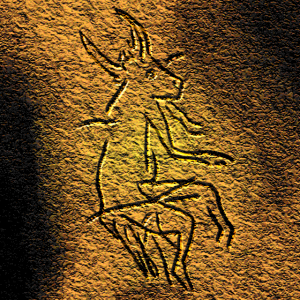
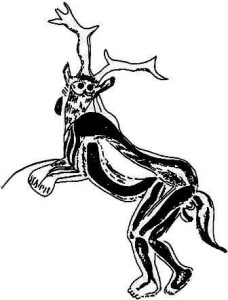
Artists used charcoal and mineral pigments, such as ocher (see Figure 36.9 for a photo of an ocher crayon from Blombos Cave), and may have applied some of the shading by chewing the pigments and spitting them onto the walls, resulting in an air-brushed effect. There is a great demonstration of that practice in the third segment of the public television series In Search of Human Origins (NOVA 1994).
The art may have served a variety of purposes. First, it is difficult not to imagine their aesthetic and emotional value, e.g. accompanying stories and myths. They may have been used for more utilitarian purposes, such as hunting strategies or keeping records. Some might have served a social function, such as communication within and between groups or education. Finally, of course, there is their proposed use in magic and ritual. Some art is found deep within caves in association with primitive stone lamps and children’s footprints. Some of the caves were discovered by divers, and thus the archaeological record was not disturbed, i.e. they were not modern footprints. It is easy to see why this has been interpreted as possible evidence of initiation rituals.
While they drew and painted on outer walls as well as inside caves, the cave paintings survived better. The French site of Lascaux Cave (18 kya) (see Figures 36.25 and 36.26) is renowned for the color and beauty of its animal depictions, especially those seen in the “Great Hall of Bulls.” At the cave site of Grotte Chauvet, France (~30 kya) (see Figure 36.27), more than 300 animals are depicted, many of which are not seen elsewhere, such as panthers and lions. Figures 36.29 and 36.30 show maps of the Spanish cave of La Pasiega (<20 kya), giving you some idea of the labyrinthine nature of some of the cave systems and richness of the galleries. Figures and forms in the cave number over 700 and consist of the following:
97 deer (69 females and 28 males), 80 horses, 32 ibex, 31 cattle (17 bison and 14 aurochs), two reindeer, a carnivorous animal, a chamois, a megaloceros, a bird and a fish; also there may be a mammoth and about 40 quadrupeds not clearly identified; also the ideomorphs, such as roof-shaped and other surprisingly varied symbols (more than 130), and very often including various anthropomorphs and hundreds of marks and partly erased traces. (Wikipedia contributors 2015a)
Another famous Spanish cave site is Altamira (15 kya) (see Figure 36.28). The cave is about one kilometer long (Chivers, 2004) and contains polychromatic renderings of large mammals, especially bison, and human hand prints.
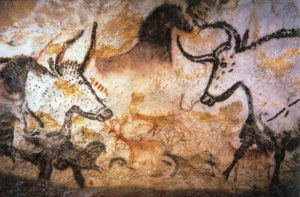
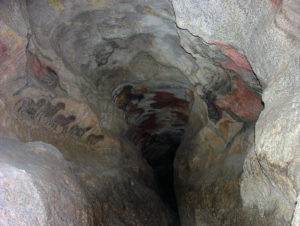
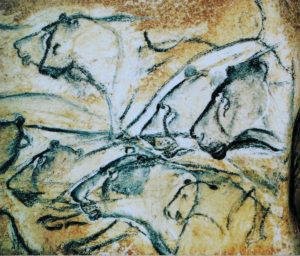
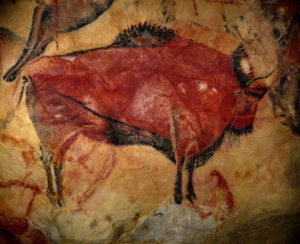


It is of interest that some of the most magnificent animal art is located in the most acoustically resonant areas within caves. It conjures images of our ancestors having special ceremonies or gatherings. Some musical instruments have survived in the form of bone flutes, percussion instruments, and a possible lithiphone (a stone xylophone). Their music would have been amplified, and with the addition of flickering flames, the wall images would have seemingly come alive!
AMH invented pottery, with the earliest evidence being fired-clay animals from the Czech Republic. The most famous sculptures are the Venus figurines (i.e. fertility goddesses) that have been found from Western Europe to Siberia. They are usually clay or stone depictions (also wood, bone, and ivory) of obese women with pronounced breasts and buttocks. They were originally thought to have been produced by men for fertility purposes. A more recent interpretation is that they were self-sculptures by women. That may explain why they were usually faceless and why body parts closest to the eyes were large and disproportionate compared with their tiny feet. Another idea suggests their use as obstetrical aids. Other sculptures were created via bas-relief on walls and rocks, which involves carving some dimensionality into the façade (see the Venus of Laussel, Figure 36.31), and there were also engraved tools, jewelry, and so forth.
The idea of fecund women as fertility goddesses is an example of sympathetic magic, i.e. depicting what one would like to happen. Obese women would have been better able to carry and nurse their babies so that they had better chances of survival. The same could be said for hunting scenes and game animals. Men may have been hoping for safe and successful hunting or an increase in the local game.
Other interesting sculptures came from the following sites or areas:
- Le Tuc d’Audoubert, France:
- Footprints (see Figure 36.32).
- Two 1 m clay bisons found propped up in the middle of a small chamber inside the cave.
- Grotte de Montespan, France:
- Children’s footprints.
- Clay figures of a bear, a lion, and other animals propped up against the cave’s walls.
- Czech Republic:
- Fired animal figurines (27 kya).
- “Oldest human portrait” (26 kya) carved from mammoth ivory and possibly attached to a staff or baton, showing great detail in the eyes, hair, mouth, and expression.
- El Juyo, Spain (14 kya):
- Stone figure on which one side of the face is a smiling man and the other is a feline predator, discovered in a possible ceremonial sanctuary.

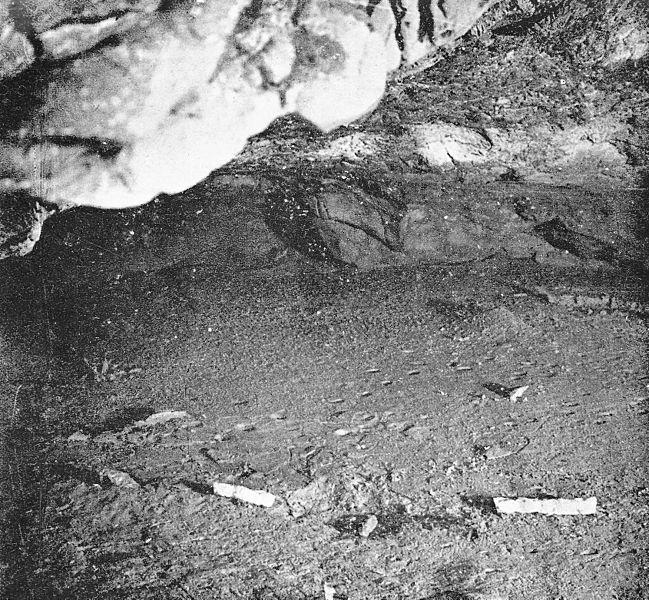
In addition to murals and sculptures, early humans also decorated their tools and bodies. Ocher is found in burials and was likely used to color the body, just as seen in many modern indigenous groups. Depending on the mineral composition, ocher is found in a variety of colors: yellow, orange, rust, brown, etc. They also made and wore jewelry and decorated their clothes with beads. At the Sungir site near Moscow (see more in section on burial practices), two children and an old man were buried in garments that were covered with thousands of ivory beads, thought to have taken an hour each to produce.
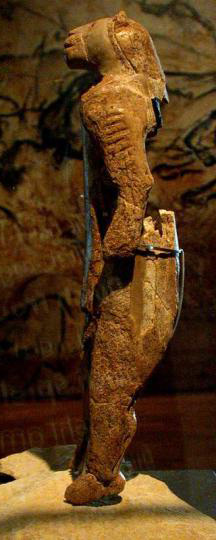
The earliest intentional burials that have been discovered for AMH are from the Middle East and dated to 120–80 kya. As mentioned, they not only buried their dead but also included grave goods and decorated the bodies in ritual fashion. Some Paleolithic cultures cremated remains. Mass burials have been found at some sites. Burial practices included placing the body in a flexed position, as the neandertals did, or supine and, in a few instances, covered with a slab of rock. Two interesting burials were found at Italian and Russian sites. At the site of Grotte des Enfants, Italy, two youngsters were decorated with hundreds of shells and pierced animal teeth. At the famous site of Sungir (see Figures 36.34 and 36.35) near Moscow, three interesting burials were found. In one grave, a nine-year-old and a twelve- or thirteen-year-old were buried together. They were flanked by two mammoth bone spears. The tusks would have had to have been boiled in a pit of water, using hot rocks, in order to straighten them. Ten thousand beads were sewn to their clothes, and the bodies were decorated with hundreds of perforated fox canines (remember that each fox has only four large canines!), carved ivory animals, pins, and pendants. They were placed on a bed of ocher. A 40-year-old man was also honored in death. His clothes were also decorated with thousands of beads, and he wore ivory bracelets. He too was placed on a bed of ocher.
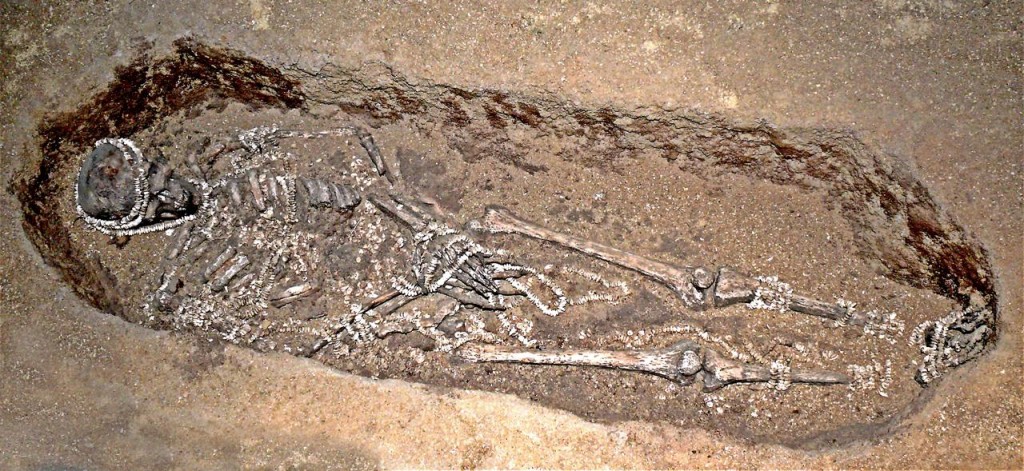
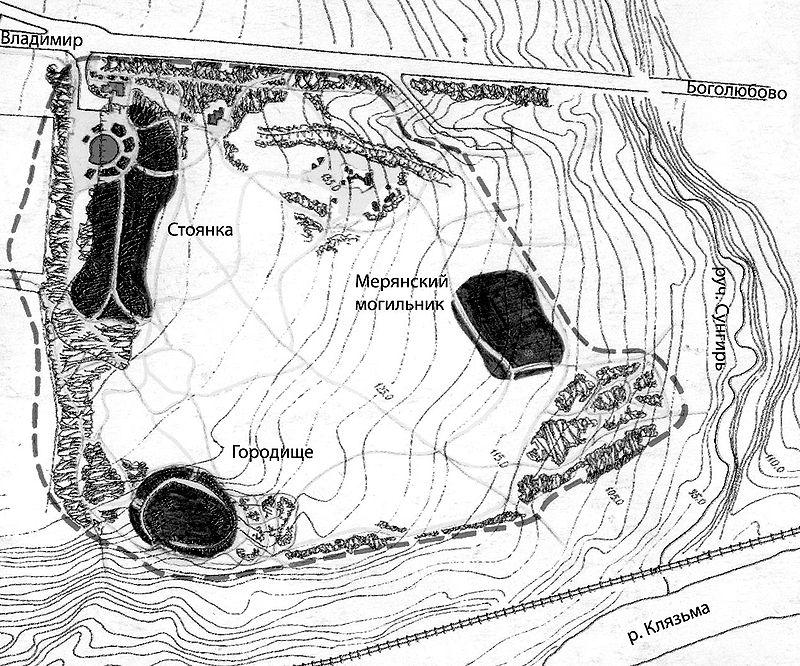
In conclusion, I found this great timeline of the Upper Paleolithic (Wikipedia contributors 2015j):
Timeline of the Upper Paleolithic
45,000–43,000
- Earliest evidence of modern humans found in Europe, in Southern Italy.
43,000–41,000
- At Ksar Akil in Lebanon, ornaments and skeletal remains of modern humans are dated to this period.
- Denisova hominin live in the Altai Mountains, Russia.
40,000–35,000 BC
- Early cultural center in the Swabian Alps.
- Earliest figurative art (Venus of Schelklingen, Germany).
- Beginning of the Aurignacian.
- The first flutes appear in Germany.
- Lion-Human created from Hohlenstein-Stadel.
39,000 BC
- Most of the giant vertebrates and megafauna in Australia became extinct, around the time of the arrival of humans.
38,000 BC
- Examples of cave art in Spain are dated to around 38,000 BC, making them the oldest examples of art yet discovered in Europe.
38,000 BC–29,000 BC
- Wall painting with horses, rhinoceroses, and aurochs, Chauvet Cave, Vallon-Pont-d’Arc, Ardéche gorge, France, is made.
35,000 BC
- Zar, Yataghyeri, Damjili and Taghlar caves in Azerbaijan
- First evidence of people inhabiting Japan.
32,000 BC
- Europeans understand how to harden clay figures by firing them in an oven at high temperatures.
30,000 BC
- First ground stone tools appear in Japan.
- Invention of the bow and arrow.
29,000–25,000 BC
- Venus of Dolní Věstonice, Czech Republic. It is the oldest known ceramic in the world.
- The “Red Lady of Paviland” lived around 29,000–26,000 years ago. Recent evidence has come to light that he was a tribal chief. (Note: it was a male skeleton dyed with red ocher.)
23,000 BC
- Venus of Petřkovice (Petřkovická venuše in Czech) from Petřkovice in Ostrava, Czech Republic, was made.
22,000 BC
- Last Glacial Maximum.
- Venus of Brassempouy, Grotte du Pape, Brassempouy, Landes, France, was made.
- Venus of Willendorf, Austria, was made.
20,000 BC
- Last Glacial Maximum. Mean sea levels are believed to be 110 to 120 meters (361 to 394 ft) lower than present, with the direct implication that many coastal and lower riverine valley archaeological sites of interest are today under water.
18,000 BC
- Spotted Horses, Pech Merle cave, Dordogne, France are painted.
18,000 BC–11,000 BC
- Ibex-headed spear thrower, from Le Mas d’Azil, Ariège, France.
18,000 BC–12,000 BC
17,000 BC
- Spotted human hands, Pech Merle cave, Dordogne, France are painted.
17,000 BC–15,000 BC
- Hall of Bulls, Lascaux caves, France is painted.
- Bird-Headed man with bison and Rhinoceros, Lascaux caves, is painted.
- Lamp with ibex design, from La Mouthe cave, Dordogne, France, is made.
16,500 BC
- Paintings in Cosquer cave, where the cave mouth is now under water at Cap Margiou, France were made.
15,000 BC
- Bison, Le Tuc d’Audoubert, Ariège, France.
15,000 BC–12,000 BC
- Paleo-Indians move across North America, then southward through Central America.
- “Pregnant woman” from Laugerie-Basse, France was made.
14,000 BC
- Paleo-Indians searched for big game near what is now the Hovenweep National Monument in Colorado and Utah.
- Bison, on the ceiling of a cave at Altamira, Spain, is painted.
- Domestication of reindeer.
13,000 BC
- Beginning of the Holocene extinction.
- Earliest evidence of warfare (found in the Americas).
11,500 BC–10,000 BC
11,000 BC
- First evidence of human settlement in Argentina.
- The “Arlington Springs Man” dies on the island of Santa Rosa, off the coast of California.
- Human remains deposited in caves which are now located off the coast of Yucatán.
10,500 BC
- Stone Age Creswellian culture settlement on Hengistbury Head, England, dates from around this year.
….And the rest, as they say, is “history”!

